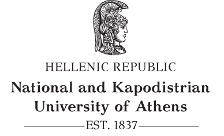- Αρχική
- THE PROGRAM
-
MODULES
- THE ARCHAEOLOGY OF BRONZE AGE AEGEAN (1010)
- KEY THEMES IN EASTERN MEDITERRANEAN ARCHAEOLOGY (1020)
- STATE FORMATION AND THE RISE OF POWER IN AN INSULAR WORLD: THE ARCHAEOLOGY OF MINOAN CRETE (3020)
- THE ARCHAEOLOGY OF MYCENAEAN GREECE (1050)
- COLLAPSE AND TRANSFORMATION: CRISIS, RESILIENCE, AND REORGANIZATION FROM THE LATE THIRD TO EARLY FIRST MILLENNIUM BCE IN THE EASTERN MEDITERRANEAN (3030)
- UNDERSTANDING THE ARCHAEOLOGICAL RECORD: PREHISTORIC CYPRUS AND THE EAST MEDITERRANEAN (2080)
- THE VISUAL CULTURES OF CLASSICAL GREECE (1030)
- ANCIENT GREEK SCULPTURE (1080)
- ATTIC POTTERY OF THE ARCHAIC AND CLASSICAL PERIODS (1090)
- THE ARCHITECTURE OF THE MYSTERY CULTS (2090)
- THE ARCHAEOLOGY OF DEATH IN THE ANCIENT GREEK WORLD (3010)
- STAFF
- ACTIVITIES
- ADMISSION
- RESOURCES
- CONTACT US
- NEWS AND EVENTS
ATTIC POTTERY OF THE ARCHAIC AND CLASSICAL PERIODS (1090)
Spring Semester, Optional module, 10 ECTS.
Instructor: Eurydice Kefalidou & Nikolas Charokopos
Summary
This course examines an important category of Greek art, the fine painted pottery of Athens and Attica. The superior quality of Attic clay, pigment, and decoration, first in the black-figure and later in the red-figure technique, quickly enabled Attic vase painters to overtake those of other local workshops so that Athens increasingly became the dominant centre for Greek figured pottery. Attic vases bear numerous depictions that reflect aspects of everyday life, myth, cult and thought from the 7th to the 4th centuries BCE. Moreover, many of these pots were luxury goods that were being exported in large quantities all over the Mediterranean and the Black Sea, thus making trade and communication routes visible in the archaeological record. By carefully examining the vases of the most important Attic painters, we will explore the unique perspective that this fascinating visual culture gives us on life in ancient Greece. We will investigate the relationship between shape and decoration as well as the main methods of visual narration in order to approach the ideological and social/political perspectives of the Archaic and Classical period.
Learning outcomes
By the end of this course students should be familiar with:
- the basic terminology of Greek pottery (techniques of manufacture and decoration, shapes and uses).
- the methods of visual narration and the main methodologies employed in their study.
- the importance and basic interpretative questions of narrative scenes painted on vases and how these scenes contribute to the broader study of the society that created them, as well as to the study of Greek literature, history and Greek material culture in general.
The students, after the completion of the course, they should also be able to:
- form and express their own opinions about the study of visual arts as a means of learning more about ancient Greek society, politics, economy, as well as religion and cult, everyday life, customs and other topics.
- raise fundamental questions/points about how images function as historical sources, and how they can be used alongside other categories of evidence on ancient Greek culture.
Syllabus
The course consists of the following thematic sections:
- Introduction to the chronology, shapes, techniques, and uses of fine painted pottery of Athens and Attica: The superior quality of Attic clay, pigments, and decoration enabled Attic potters to overtake those of other workshops, so that Athens increasingly becomes the dominant center for Greek figured pottery.
- Introduction to pottery iconography: Discussion of the methodology of visual narration. Attic vases bear numerous depictions that reflect aspects of everyday life, myth, cult and thought from the 7th to the 4th centuries BCE.
- Pottery trade in the ancient Mediterranean: Pots were luxury goods that were being exported in large quantities all over the Mediterranean and the Black Sea, thus making trade and communication routes visible in the archaeological record.
- Summary - Conclusions: Pottery and iconography as a means to approach aspects of life in ancient Greece through its fascinating visual culture.
Assessment
*Essay: 70%
Oral presentation: 20%
Overall participation in class: 10%
*Essay (3.500-5.000 words). A list of indicative topics will be provided, but students are strongly encouraged to discuss and personalize the essay topic with the course coordinator.
Student's study hours
Lectures: 24
Educational visits: 5
Interactive teaching: 26
Study and analysis of bibliography: 20
Cooperation with the instructor: 15
Tutorials: 10
Independent study (incl. project): 70
Essay writing: 80
Course total: 250
Recommended bibliography
Boardman, J. 2001. The History of Greek Vases: Potters, Painters and Pictures. London.
Clark, A., Elston, M. & Hart, M. L. 2002. Understanding Greek Vases. A Guide to Terms, Styles, and Techniques. Los Angeles.
Mertens, J. R. 2010. How to Read Greek Vases. Yale-New Haven-London 2010.
Rasmussen, T. & Spivey, N. (eds) 1991. Looking at Greek Vases. Cambridge.
Robertson, M. 1992.The Art of Vase-Painting in Classical Athens. Cambridge.
Shapiro, H. A. 1994. Myth into Art. Poet and Painter in Classical Greece. London.
Sparkes, B. Α. 1991. Greek Pottery. An Introduction. Manchester-New York.
Sparkes, B. Α. 2013. The Red and the Black: Studies in Greek Pottery (2nd edition). London-New York.
Stansbury-O'Donnell, M.D. 1999. Pictorial Narrative in Ancient Greek Art. Cambridge.
Stansbury-O’Donnell, M. D. 2006. Vase Painting, Gender, and Social Identity in Archaic Athens. Cambridge.
Woodford, S. 2015. An Introduction to Greek Art. Sculpture and Vase Painting in the Archaic and Classical Periods (2nd edition). London.
